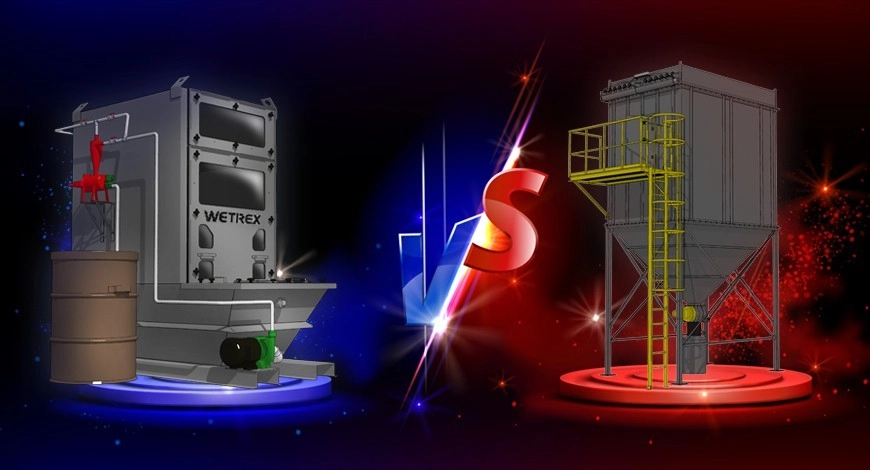
Practical Guide to Wet and Dry Dust Collectors – Part 1
In your research, do you wonder what differentiates the various types of systems, especially wet and dry dust collectors? Here is an overview of the aspects that influence this choice!
Dry and Wet Dust Collectors: How Do They Work?
Based on the three major aerosol separation techniques, a wet system uses immersion to separate the dust from the air and then contain it in a retention basin. A dry dust collector, however, uses centrifugation or filtering to separate the particles from the air stream.
Wet Dust Collectors
The exhaust air is drawn into the Wetrex. It is first submerged into a tank filled with water. Next, an arrangement of baffles creates a vortex that acts as a particle separator. These are then trapped in the tank and form a ‘mud’ (which is then collected during maintenance). Filtered air exits the dust collector into the atmosphere or is recirculated within the work environment.
In general, wet scrubbers are recommended in the presence of sparks or particles with exothermic or pyrophoric (self-ignition) properties, such as in smelters, metallurgical or aerospace industries.
Choosing this unit is justified by the speed at which pressure generation, due to particle explosion, can be contained. The dust collector is able to mitigate the explosion risk because water extinguishes he sparks; whereas the fire protection accessories on a dry collector wouldn’t even have time to activate. For this reason, the management of certain explosive materials is guided by various OHS regulatory authorities that require the use of a wet dust collector.
Dry Dust Collectors
This large family consists of several types of dust collectors, including baghouse, cartridge, and cyclone dust collectors to name just a few. Typically, the exhaust air enters the collector, where the heavier particles fall downward into the hopper, while the air is extracted upward.
Cyclone-type units (centrifugation) are rarely used alone because they don’t really meet the standards governing the rates of emissions released into the air. Often used as a pre-filter or a spark arrestor upstream from the main dust collection system, this low-maintenance technology is also frequently installed at the exit of the loop of a pneumatic conveyor system.
For filter systems, there are several types of filter media that adapt to different conditions, such as humidity and air temperature or particle type (shape, particle size, electrostatic charge, explosiveness, etc.) Resistance requirements, especially for mold, abrasion or acidity, also come into play when choosing the right filter.
Where to Start for Selecting a Suitable Dust Collector
As we already mentioned a few weeks ago, there are a number of factors to consider when selecting a dust collector. First, it is important to know the nature of the particles. Submicron particles, such as welding smoke or fine alumina particles, cannot be captured by a wet collector; they are too volatile. A dry cartridge unit would be preferable. On the other hand, water-soluble particles (yeast or animal fats found in the agri-food industry) can be captured without issue by a wet system.
Other limitations come into play. For example, some metals, such as aluminium dust, react when in contact with water and create hydrogen gas. Once a critical threshold is exceeded, a spark can cause an explosion inside a wet dust collector if the gas builds up inside it. Since this type of unit is sealed, adequate ventilation must be ensured, even when the unit is shut down.
The lower portion of the graph represents the maximum pressure some materials can withstand while the upper portion indicates the maximum pressure some materials can generate. As the maximum pressure increases, the use of a wet dust collector is recommended.
Based on the physical properties of the particles and their explosiveness rate (calculated using measurements such as KST and maximum explosion pressure), there are several standards to be met, including NFPA 484. These standards require such things as ventilation within a wet collector, and allow (under certain conditions) the addition of a secondary dry filter section at the air outlet of a wet unit in order to meet certain hygiene or air emission control standards.
The Secret to Choosing the Right Solution? Consult the Experts!
It’s your operational needs (nature of the dust, equipment, energy recovery, etc.) and the layout of your facilities that will tip the balance in favour of a dry or wet dust collector. In addition to the overall analysis of these factors, the OHS standards must also be met. Watch for our next publication, which will look at the pros and cons of wet and dry systems.
Our mission? To find an integrated solution and customize it to your situation. As general contractors specializing in ventilation, dust control and air processing, we look after your projects from A to Z. We look forward to hearing from you!
